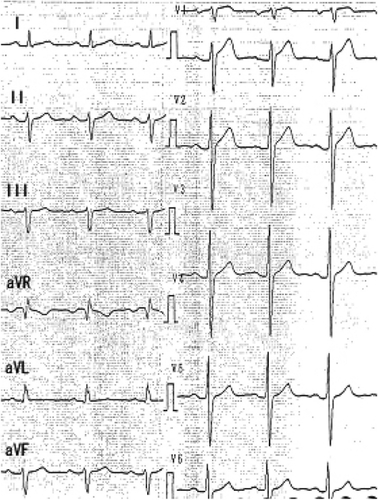Abstract
Rhythm control therapy by sodium channel blockers is widely performed for the treatment of paroxysmal atrial fibrillation. Here, we present a case of acquired Brugada syndrome by pill-in-the-pocket treatment using pilsicainide. It is important that this therapy should be applied only after confirming the drug safety to the patients.
Case report
A 62-year-old male was transferred to the emergency department due to presyncopal attacks developed after taking pilsicainide. The patient has history of paroxysmal atrial fibrillation and stroke and was treated by cibenzoline 300 mg/day in combination with adequate anticoagulation. Since his atrial fibrillation could not be suppressed by cibenzoline alone, his home doctor prescribed additional pilsicainide of 100 mg for pill-in-the-pocket treatment. This was a first attempt of the pill-in-the-pocket treatment for this patient. His electrocardiography (ECG) on arrival shows 2 to 1 atrial flutter, interventricular conduction disturbance, and coved-type ST segment elevation in leads V1-2 consistent with type I Brugada ECGCitation1 (). His previous ECG taken during daily cibenzoline treatment did not show these abnormalities (). His serum electrolyte and renal function were normal. Antiarrhythmic drugs were terminated after admission and the ECG returned normal and his clinical course was uneventful. Based on the ECG findings on admission, there are 2 possible causes of the presyncopal attacks in this patient. One possibility is due to nonsustained ventricular fibrillation which was associated with Brugada syndrome, and another possibility is 1 to 1 atrio-ventricular conduction during the atrial flutter. Sodium channel blockers are now widely used for rhythm control therapy for paroxysmal atrial fibrillation.Citation2 However, physicians must care for the side effects. The class Ic drug can unmask Brugada syndrome or induce atrial flutter called “Ic flutter”. The pill-in-the-pocket treatment for atrial fibrillation is recognized as safe and effective therapy for the rhythm control for the atrial fibrillation.Citation3 It is important that this therapy should be applied after confirming the drug safety to the patients.
Acknowledgements
We thank Jeffrey Annis for his linguistic advice.
Disclosure
The authors report no conflicts of interest in this work.
References
- AntzelevitchCBrugadaPBorggrefeMBrugada syndrome: report of the second consensus conference: endorsed by the Heart Rhythm Society and the European Heart Rhythm AssociationCirculation2005111565967015655131
- Guidelines for Pharmacotherapy of Atrial Fibrillation (JCS 2008)Circ J.200872Suppl IV15811638 (Japanese).
- AlboniPBottoGLBaldiNOutpatient treatment of recent-onset atrial fibrillation with the pill-in-the-pocket approachN Engl J Med20043512384239115575054

